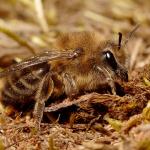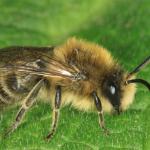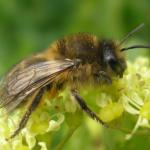Apis subterranea LINNAEUS 1758 (nec. L. 1758); Apis cinerea GEOFFROY 1785 (nec. SCHRANK); Colletes pilosus SPINOLA 1838; Colletes hirtus LEPELETIER 1825;
The largest of the nine British species in the genus, with a population that apparently differs slightly from the Continental race in both morphological and ecological respects. As a result, it has been recognised as a distinct subspecies, C. cunicularius celticus, by O'Toole (1974). More recently, major differences between the Continental and British populations have been found in the chemistry of the Dufour's gland secretions (Albans et al., 1980; Duffield et al., in Bell & Carde, 1984), raising the possibility that the British populations may be specifically distinct.
Historically, the species has an unusual distribution, being confined to a number of extensive coastal sand dune systems in north-west England and north-west and south Wales. It is often locally abundant; for example, at Kenfig dunes, West Glamorgan, there have been nesting aggregations of up to 18,000 nests (C O'Toole, pers. obs.). In 2011 a number of inland sites were recorded, with populations in, Shropshire, Nottinghamshire and Worcestershire.
Listed as Rare (RDB3) in Shirt (1987) and Falk (1991).
Large, mature coastal sand dunes, wherever creeping willow grows. Recent records (2011) also show that the species can be found on sandy heathland and in disused sand pits inland
This is the only British Colletes to fly in the spring (early April to the end of May, rarely mid-June), rather than in the summer or autumn.
The nest comprises a slightly inclined tunnel, some 45-55 cm deep, with cells built at the ends of side branches. These branches are concentrated in the deepest quarter of the nest, so that the vertical distance between the shallowest and deepest cells is only 4-8 cm. The mass emergence of males (from the upper cells) occurs in the afternoon of the day before mass emergence of females. Like all species of Colletes, C. cunicularius lines its brood cells with a transparent cellophane-like membrane. This is waterproof, resistant to fungal attack and presumably maintains the correct level of humidity during larval development. The source of the membrane is a liquid secretion of the Dufour's gland in the abdomen. The female bee uses her short, bilobed tongue as a kind of paint brush to spread the oily secretion over the internal surface of her cell. It dries to form a clear membrane.
In addition to creeping willow, both sexes have been observed in South Glamorgan by R Paxton (pers. comm.) visiting dandelion (Taraxacum sp.) flowers, presumably only for nectar. In Brittany, S Roberts has observed both sexes nectaring at blackthorn (Prunus spinosa).
In continental Europe, the species is parastised by Sphecodes albilabris (Westrich, 1989; Söderman & Leinonen, 2003).
Profile written: 1999
Proofed & updated in January 2012




